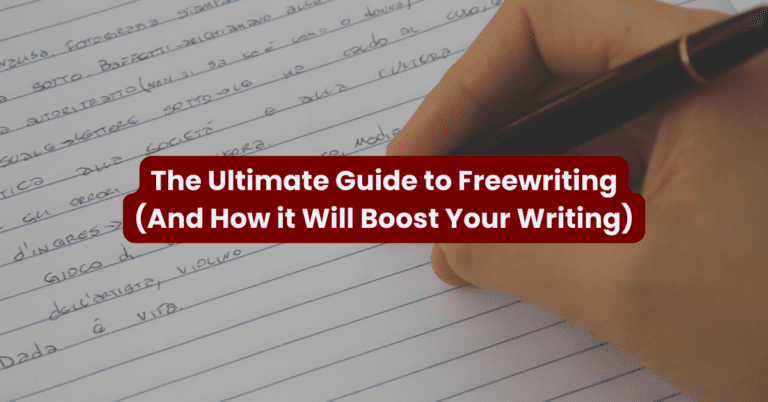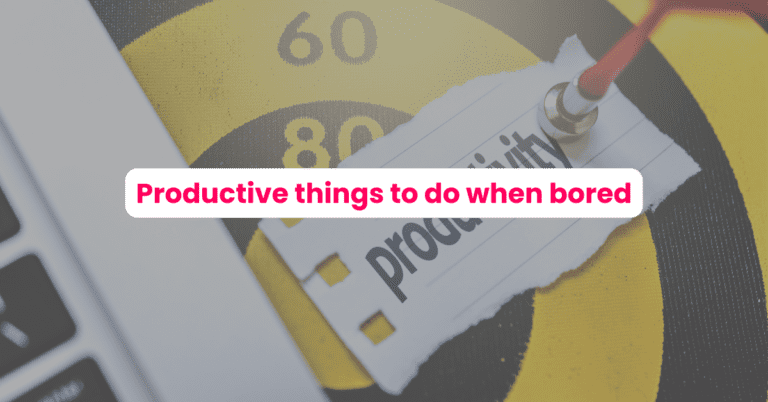Did you know that the average person spends over 6 hours and 48 minutes a day reading on various digital devices? With so much time spent hunched over phones and computers, improper reading posture has become a widespread problem.
This persistent bad posture can lead to back, neck, and shoulder pain, eye strain, muscle imbalances, and even poor breathing. Yikes!
Establishing proper reading posture is essential for supporting long-term health, comfort, and concentration while reading.
And this post will teach you the fundamentals of maintaining good reading posture in various positions, whether you’re sitting at a desk, lounging on the couch, or lying in bed.
Please note that this is NOT professional medical advice. Always get advice from a medical professional and work with a physical therapist to manage incorrect posture. However, all the information here is curated from reliable sources to find the best position to read easily.
With some simple adjustments, you can dramatically improve your reading experience and reduce the negative effects of constant screen time on your body. Read on to learn easy posture tips, exercises, and habit adjustments that can prevent pain and support healthy reading at any age.
What is Reading Posture?


Reading posture refers to the way your body is positioned while reading.
It involves the orientation and alignment of your head, neck, shoulders, back, arms, and hands as you hold reading material and take in the words on the page.
The goal is to find an aligned, comfortable posture that enables you to focus on the text without struggling against your own body. Small adjustments and proper positioning of yourself and your book or device can make a big difference in reading posture.
What is the Importance of Proper Reading Posture
Maintaining proper posture while reading offers several benefits that can make reading more enjoyable and effective. Here are the benefits of good reading posture:
- Helps avoid fatigue and discomfort that can distract from reading comprehension.
- Helps avoid eye strain by keeping the reading material at an optimal distance and angle.
- Encourages proper breathing, which increases oxygen flow to the brain and can improve concentration.
- Sitting upright also activates core muscles, which improves alertness. Having the head balanced above the spine in a neutral position reduces strain on the neck and shoulders.
Overall, good reading posture allows you to stay focused and absorb what you’re reading for longer periods. It helps avoid distractions from discomfort that can disrupt reading flow.
Not to mention, proper posture is especially important for students to maintain focus during study sessions.
Some Common and Poor Reading Postures
Let’s start by looking at some of the most common poor reading postures to avoid.
1. Slouching
When slouching, your spine curves outward, and the head juts forward. This causes the back muscles to overstretch and can lead to back pain and muscle strain. Slouching also compresses the lungs and digestive organs.
2. Leaning Forward
Leaning forward strains the neck as the head pushes forward. Hunching over reading material can cause neck cramping and upper back pain. This posture leads to poor breathing as it compresses the lungs and diaphragm.
3. Craning Neck
Craning or bending the neck forward or to the side puts stress on the cervical vertebrae. This poor head and neck posture leads to muscle spasms and pinched nerves.
Being aware of poor reading postures means you’re better prepared to find the best reading position for your needs. Let’s dive into reading positions to help you maintain a neutral spine and read longer comfortably.
What is the Best Posture for Reading
Let’s break down your ideal reading posture by looking at different parts of your body, your lighting, devices, and the objects you use while reading.
Start With Your Head Position
To maintain good posture while reading, keep your head up and avoid looking down toward the book or device. Bending your neck forward for prolonged periods puts strain on your neck muscles and can lead to pain and stiffness over time.
Instead, hold your head up straight in a neutral position as if balancing an object on top of it. Your ears should be aligned with your shoulders rather than jutting forward. This takes tension off your neck and avoids hunching over.
Bring the book or device up towards your eyes rather than dipping your head down. Your eyes should be able to stay level while reading rather than straining to look down. This will feel unnatural at first but gets easier with practice and awareness.
Align Your Shoulders
Shoulders should be relaxed and down, not hunched up near the ears when reading. Hunching the shoulders creates tension that can lead to neck, shoulder, and upper back pain.
Allow the shoulders to settle into a neutral position without forcing them back. Imagine a straight line from the ear down to the shoulder – the shoulder should sit just slightly in front of the ear. Keeping the shoulders lowered away from the ears helps reduce muscle strain.
Periodically roll the shoulders during longer reading sessions to relax the muscles. Shrugging up and back down resets the shoulders into proper alignment. It also allows blood flow to nourish the muscles and prevent fatigue.
Align and Rest Your Legs and Feet
When reading, it’s important to have proper leg and foot positioning to avoid strain and promote good posture. Your legs should be bent at a 90-degree angle with your knees level with your hips. This reduces strain on your back compared to having your legs extended out.
You’ll want both feet flat on the floor or a footrest to provide stability and support. Avoid crossing your legs or ankles, as this can restrict blood flow. You may also try placing a pillow under your knees when sitting to provide additional support. Some sources recommend having your legs extended out straight if reading while reclining in bed (source).
Overall, keeping your legs and feet in a comfortable, supported position reduces strain when reading for extended periods.
More Tips to Maintain Proper Posture for Reading
Besides your own physical posture, you should consider your use of furniture, devices, lighting, and other factors to have better posture.
1. Take Care of Your Back Support


You should have proper back support when reading for maintaining good posture and avoiding strain or fatigue. There are a few options for providing back support while reading:
Chairs – When sitting in a chair, make sure to choose one with good lumbar support. An adjustable office chair that allows you to align the backrest to the natural curve of your spine is ideal. If your chair doesn’t have adjustable lumbar support, you can use a back pillow or cushion to help fill the space between your lower back and the chair.
Cushions – Back cushions and lumbar pillows that contour to the curve of your back are a great portable option to provide support when sitting in a regular chair or on the couch. Look for cushions made of firm memory foam or with an internal support frame. Wedge cushions can also help adjust the angle of your back.
Pillows – Special reading pillows are designed to prop up your upper back and neck to avoid hunching over. Many come with armrests as well for extra support. Options like the ComfortSpa Reading Pillow or pillows with shredded memory foam provide a molded shape for the contours of your spine. Side pockets allow convenient storage for books, remotes, or phones.
Adjusting your back support while reading can make a big difference in avoiding fatigue or discomfort over time. Experiment with different types of ergonomic cushions and pillows to find what provides you the best upright posture.
2. Mind How You Use Devices
Different devices require different postures for optimal reading.
Desktops


For desktop computers and laptops, it’s important to:
- Have the screen at eye level and about arm’s length away to avoid straining your neck.
- Use a stand or adjustable arm for your screen to get the ideal height and distance.
- Your shoulders should be relaxed, and elbows bent at 90 degrees with wrists straight when using the keyboard and mouse.
- Sit up straight and avoid hunching over. Consider using a document holder positioned next to your screen at the same height and angle.
Tablets
With tablets, avoid holding the device flat with your arms extended straight out. This strains the neck and shoulders. Instead, prop your tablet on a stand, pillow, or lap desk to bring it closer and tilt the screen up. Sit comfortably and bring the tablet into your lap. Avoid looking down for long periods.
Phones


Reading on phones requires frequent breaks and limited duration. Hold the phone up with the top of the screen at or slightly below eye level. Sit upright and bring the phone in closer to your body to avoid hunching over. Avoid lying on your side or back, which puts strain on the neck. Take frequent breaks by setting the phone down in your lap.
3. Choose Lighting Carefully
Proper lighting is essential for reading comfort and to avoid eye strain. The ideal reading light should be bright enough to illuminate the page without causing glare.
As we age, we need brighter light for comfortable reading. Using a dedicated reading light allows you to position it to avoid glare while providing ample illumination on the page.
Full spectrum or natural daylight bulbs that don’t emit UV rays are a good choice as they reduce eye fatigue compared to standard incandescent bulbs.
Position the light above your shoulder, angled down towards the book. This minimizes glare off the page.
If reading in bed, clip-on book lights with several adjustable joints work well to direct light where needed without glare. Wall sconces or accent lamps can also provide good reading light if positioned properly.
Low light can cause unnecessary strain, especially when you’re reading for an extended period. So, make sure you get a good reading light for bed.
Avoid overhead lights, which can create distracting shadows on the page. Use a dimmer switch or smart bulbs like Philips Hue to adjust brightness.
Also, just avoid reading when it’s tiring. A good book should make you feel rested and shouldn’t be a chore.
4. Take Breaks
Taking regular breaks is important when reading for extended periods of time to avoid fatigue and strain. Stand up and walk around for a few minutes periodically to give your eyes a rest and improve circulation. Stretch your neck, shoulders, back, and arms gently to relieve tension. Avoid straining your eyes by looking out a window or into the distance to give your eye muscles a break.
You may want to set a timer to remind yourself to take a break every 20-30 minutes. Getting up frequently prevents you from staying in one position too long. Take mini breaks to blink, roll your eyes, and rotate your wrists. Staying in the same position for hours can lead to pain and discomfort.
5. Set Reminders
While reading, it’s easy to fall into poor posture habits without realizing it. Setting reminders can help keep you aware of maintaining an upright, aligned position. There are a few options for setting posture reminders while reading:
- Apps – There are various apps available that can remind you to adjust your posture at set intervals, such as SmartPosture. These use notifications or even wearable sensors to alert you when slouching.
- Timers – Simple countdown timers or alarms on your phone, watch, or computer can serve as useful posture reminders while reading. Set them to go off every 20-30 minutes as a cue to sit up properly. This can also help you avoid falling asleep as you read.
- Fitness Trackers – Many fitness trackers have customizable alerts, including posture reminders if worn on the upper back. Consider enabling these if you already own a fitness band.
Remembering to consciously correct posture is challenging. Using reminders and prompts can instill beneficial reading habits over time.
6. Take Care of Your Desk and Chair Setup
Having the right desk and chair setup is crucial for maintaining proper posture while reading. An ergonomic workspace allows your body to be in a relaxed yet supported position.
When sitting at a desk, it’s important that your feet rest flat on the floor and your thighs are parallel to the ground. If your desk chair is too high, use a footrest to elevate your feet.
Adjust your chair height so your elbows are at a 90-110-degree angle while resting on the desk. Your eye level should be about 2-3 inches below the top of your monitor.
Sit with your back flush against the chair and use lumbar support. Chairs with adjustable lumbar support allow you to adapt the chair to your spine’s natural curve. Despite what you hear about having a ‘straight spine’, you really want to maintain the natural shape of your spine and not compress it when reading.
Your desk height should permit your shoulders to be relaxed while your elbows rest on the desk. If the desk is too high, place a cushion on your chair to lift you. If it’s too low, raise the desk using risers.
Position your keyboard and mouse directly in front of you to prevent excess reaching. Keep frequently used items within an arm’s length.
Take standing or movement breaks periodically to avoid stationary positions for too long. An adjustable desk allows you to alternate between sitting and standing.
With a proper desk and chair setup, you can maintain energy and focus while reading. Adjustments to posture can prevent pain and discomfort.
7. Lying Down vs. Upright (What to do)
Reading while lying down has some advantages but also some potential downsides compared to sitting upright.
Lying down is a comfortable and relaxed position, especially when reading for leisure. Being in a reclined position or curled-up position may help some people focus by removing distractions. Some find reading in bed helps them fall asleep more easily.
However, lying completely flat can cause strain on the neck from looking down at a book. This neck strain could lead to headaches or pain after longer reading sessions. Sitting upright helps keep the book at eye level to avoid neck strain.
Additionally, lying down may make some people more prone to dozing off, making it less ideal for studying or productive reading. Remaining upright can help maintain focus and concentration better for retention and comprehension.
Lying on your side may help avoid some neck strain versus lying completely flat. Using pillows as support can also make reading lying down more ergonomic. Overall, alternating positions between sitting and reclining can provide balance. Consider your needs and comfort to determine if lying down or remaining upright is better for your reading session.
Common Problems Caused by Poor Reading Posture
Poor reading posture can lead to several issues over time if not addressed. Two of the most common problems are:
- Hunching – When reading, people often hunch their shoulders and lean their head forward. This strains the neck and back muscles and puts extra pressure on the spine. Over time, this poor posture can lead to back and neck pain.
- Strain – Reading requires the eyes to focus on the text, usually about 16 inches away. This sustained near-focusing strains the eye muscles. Poor posture, like hunching, makes this worse by adding neck tension. Eyestrain symptoms include headaches, blurred vision, and tired eyes.
Proper posture helps avoid these common problems that arise from poor reading posture. Keeping the back straight and bringing reading material up helps avoid hunching. Taking regular breaks helps relieve eyestrain.
Improving Posture and Reading Position With Exercises
Establishing a proper reading posture is essential for maintaining spinal and shoulder health, and integrating targeted exercises into your routine can significantly aid in this. Here’s how you can start:
- Gentle Neck Rotations – Slowly move your head side to side, pausing for five seconds each. Lower your head toward your chest and then gently lift your gaze upwards to stretch different neck muscles.
- Dynamic Shoulder Circles – Raise your shoulders toward your ears, pause, then roll them back and downward. Perform this circular motion 3-5 times to loosen up shoulder tension.
- Chest Expansion Exercise – Clasp hands behind you, straighten your arms, and push your chest outward, feeling a stretch through your upper back for 10-15 seconds.
- Seated Hamstring Stretch – While seated at the edge of your seat, extend one leg out straight and bend the other so the foot is flat. Lean forward with a flat back, hold for 10-15 seconds, then switch legs.
- Forearm and Wrist Flexion/Extension – Extend your arms in front of yourself and alternately draw your hands back toward your forearms and then down. Rotate wrists smoothly in both directions.
- Periodic Standing and Movement – Every so often, stand up to stretch and mobilize your legs with a short walk to reinvigorate yourself.
- Doorframe Chest Stretches – Position your forearms on either side of a doorway. Lean gently forward to stretch the front of your shoulders and chest.
- Cat-Cow Stretch – Standing and Kneeling Variations – Strengthen your back with the cat-cow motion from a kneeling position or modified while standing.
- Core-Stabilizing Planks – Engage your core and back by holding a plank. Ensure your body forms a straight line. Beginners can start with intervals of 10-30 seconds.
Incorporate these exercises into a daily 5-10 minute regimen to promote better posture. Remember, posture awareness is key throughout your day, not just during your workout.
Conclusion – Take Back Mobility and Read More
Please be mindful of maintaining your optimal posture by aligning your neck and spine when reading. And don’t sacrifice your posture or vision just to get through extended reading sessions.
With some small adjustments to your usual reading position, you can read for longer periods comfortably while avoiding pain and fatigue. Focus on sitting up straight and bringing reading material up to eye level.
Your body will thank you.







